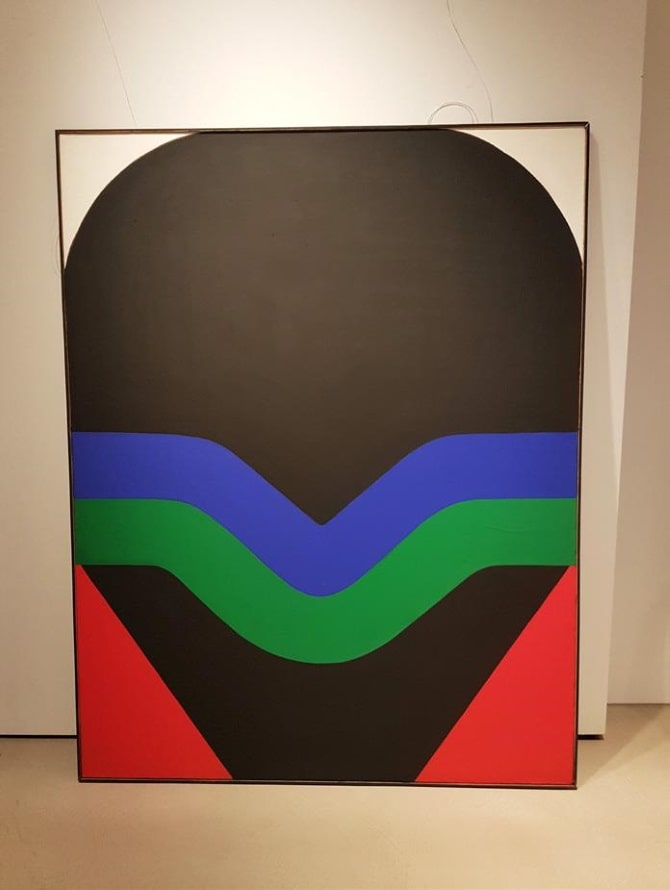The Revolution of the Color: Grisebach shows until February 23rd, 2019 vintage bags and fashion by Roberta di Camerino together with works by Georg Karl Pfahler.
Black velvet, red velvet, in between a rich hunter green, placed next to each other in three stripes. Four velvet triangles in red, blue-grey, purple and yellow, which fold into each other. When everyone else was still working with brown and black leather, so as not to attract attention with her handbags, which had to be one thing above all, quiet and functional, Giuliana Camerino (1920-2010) was already two steps further. With her Venetian label Roberta di Camerino she brought powerful and refined colour and shape creations to the musty market of the fifties. Giuliana Camerino turned the handbag from a barely noticed accessory into an independent object.

The legendary Bagonghi Bag, for example, inspired by a traditional doctor’s bag, toured the world with Grace Kelly. Liz Taylor, Gina Lollobrigida, Isabella Rossellini were all regular customers – not to mention Madonna, who was occasionally sighted with a Caravel bag on her arm. Long before Gucci made the G its own hallmark, Roberta di Camerino bags were emblazoned with a powerfully executed brass R. Giuliana Camerino was probably the inventor of the it bag. Long before anyone knew what it was.
Time to rediscover this visionary designer. With Monika Gottlieb, Grisebach was able to persuade one of the most important German collectors of vintage fashion to exhibit a cross-section of her extensive Camerino collection in Berlin. With a representative selection of mainly bags – abstract art for the arm – but also a gallery of complete looks – Camerino later began to design dresses with enchanting trompe-l’œil effects – this was probably the first time in Germany that the work of this now forgotten Italian form player could be discovered so comprehensively.

Giuliana Camerino founded her manufactory in 1945 in Venice under the name of Venice: Roberta di Camerino. The name was derived from the musical classic of the thirties: “Roberta” with Ginger Rogers and Fred Astaire – Giuliana Camerino loved this film. In 2008 she sold her brand and died only two years later at the age of 89 in Venice. Since then it has become quieter around the dancer among the fashion designers who brought the secret code of her explosive creations to a clear formula: “All colors are beautiful and go well together. If, for some reason, it seems that two people bite each other, there is a very simple solution: add a third, and it fits wonderfully.”
Georg Karl Pfahler (1926-2002) also cultivated his very own approach to color, and in this exhibition we juxtapose his works with Giuliana Camerino’s objects. Deeply influenced by his teacher Willi Baumeister as well as by the color field paintings Barnett Newmans – both appreciated each other, Newman even didn’t miss the opportunity to hang a Pfahler show at the Galerie Fischbach in New York in 1964 – Pfahler found his most concise expression in the sixties at the latest. In 1960, he called his style “formative”: for him, the entire picture represented a uniform field of color and surface. He created forms through colors. He did not attribute lines to existence from within himself; he defined them solely through color and form. Georg Karl Pfahler’s works have lost nothing of their appeal and quality to this day, since they define their pictorial surfaces and spaces impressively and even programmatically.
Our exhibition brings both positions into a mirrored and tense relationship and invites the viewer to experience precisely that moment in which two artists explore the interplay, if not the collision, of color values with their own expressive possibilities and materialities as if under a magnifying glass.
WHEN?
Opening: Monday, January 14th, 2019, 7 pm
Exhibition: Tuesday, January 15th to Saturday, February 23rd, 2019
Opening hours: Mo-Fr 10 am to 6 pm, Sat 11 am to 4 pm
WHERE?
Grisebach
Fasanenstraße 27
10719 Berlin






